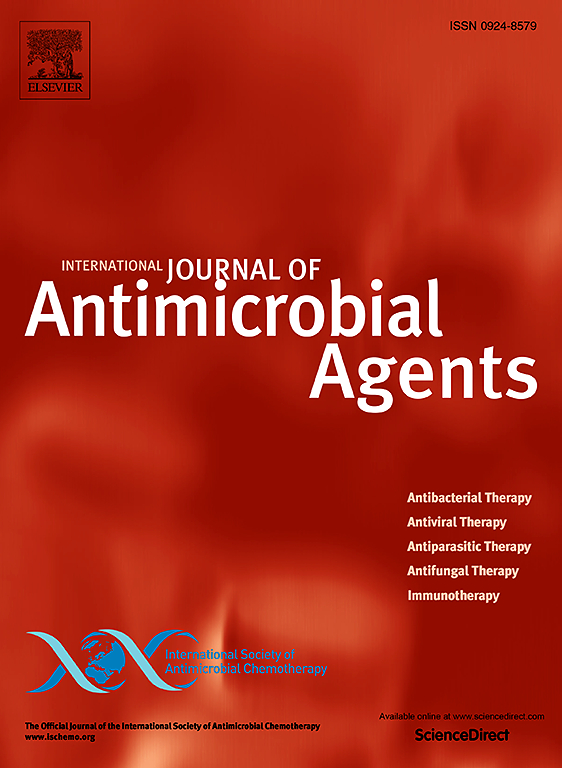Exploring the protective role of recombinant type iii interferons in respiratory infections: Insights from an Mx1-deficient mouse model
IF 4.9
2区 医学
Q1 INFECTIOUS DISEASES
International Journal of Antimicrobial Agents
Pub Date : 2025-03-11
DOI:10.1016/j.ijantimicag.2025.107491
引用次数: 0
Abstract
Background
Type III interferons (IFNs) are regarded as safe and effective preventive agents for viral infections of the respiratory tract. The effectiveness of the preventive use of type III IFNs in patients with polymorphisms in critical antiviral ISGs is particularly relevant. We utilized Balb/c mice deficient in the Mx1 gene as model organisms.
Methods
Recombinant IFNs were administered intranasally one day before infection with the mouse-adapted pandemic strain of influenza A virus (IAV), A/California/07/09 (H1N1pdm09). In the model of mixed infection (sequential infection with IAV at a sublethal dose and Staphylococcus aureus), a bacterial suspension was administered intranasally a day after IAV infection. Influenza nucleoprotein level and bacterial load were assessed in the lungs on the third day post-infection.
Results
Type III IFNs demonstrated a protective effect against infection with IAV. A single intranasal administration of IFN-λ protected mice from weight loss, reduced the level of viral nucleoprotein in lung homogenates, and significant differences in survival curves were also observed. In the case of mixed infection, a single intranasal administration of IFN-λ was associated with a decrease in bacterial load in the lungs, and minimal weight loss was observed in the mice.
Conclusion
The study demonstrated that IFN-λ can have a protective effect in Mx1-deficient Balb/c mice. These data support the universality of type III IFN use, suggesting that these preventive agents can be effective even in patients with a suboptimal genetic background.

探索重组III型干扰素在呼吸道感染中的保护作用:来自mx1缺陷小鼠模型的见解
III型干扰素(ifn)被认为是安全有效的呼吸道病毒感染预防药物。I型和III型干扰素的抗病毒作用是通过诱导干扰素刺激基因(isg)介导的,其可变性影响疾病的进程和个体对病毒的易感性。在具有关键抗病毒isg多态性的患者中预防性使用III型ifn的有效性尤为重要。在本研究中,我们以Mx1基因缺失的Balb/c小鼠作为模式生物。III型干扰素对小鼠适应型甲型流感病毒(IAV) a/ California/07/09 (H1N1pdm09)感染具有保护作用。单次鼻内给药IFN-λ可以保护小鼠免于体重减轻,降低肺匀浆中病毒核蛋白的水平,并观察到生存曲线的显着差异。在混合感染的情况下(连续感染亚致死剂量的IAV和金黄色葡萄球菌),单次鼻内给药IFN-λ与肺部细菌负荷的减少有关,并且在小鼠中观察到轻微的体重减轻。因此,本研究证明IFN-λ对mx1缺陷Balb/c小鼠具有保护作用。这些数据支持III型干扰素使用的普遍性,表明这些预防药物即使对遗传背景不理想的患者也有效。
本文章由计算机程序翻译,如有差异,请以英文原文为准。
求助全文
约1分钟内获得全文
求助全文
来源期刊
CiteScore
21.60
自引率
0.90%
发文量
176
审稿时长
36 days
期刊介绍:
The International Journal of Antimicrobial Agents is a peer-reviewed publication offering comprehensive and current reference information on the physical, pharmacological, in vitro, and clinical properties of individual antimicrobial agents, covering antiviral, antiparasitic, antibacterial, and antifungal agents. The journal not only communicates new trends and developments through authoritative review articles but also addresses the critical issue of antimicrobial resistance, both in hospital and community settings. Published content includes solicited reviews by leading experts and high-quality original research papers in the specified fields.

 求助内容:
求助内容: 应助结果提醒方式:
应助结果提醒方式:


